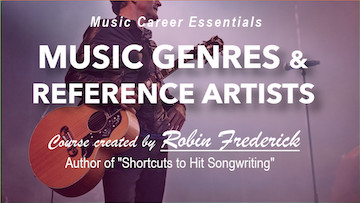The trouble with genres is this: A genre is simply what people in the music industry generally agree that it is. Everybody knows what you mean but no one can pin it down exactly. It’s an art, not a science. In other words, it’s as vague as a foggy day in London town.
But, like it or not, that’s what we’re stuck with and it has become the accepted way to rapidly communicate an idea of what your music or lyrics sound like.
It might help to think of genres the way you think of colors. If you tell me to paint your house green, it could end up being a color you definitely didn’t have in mind: lime, avocado, celadon, jade, moss, forest green, or olive green. There’s a big range of hues between lime green and jade, but we identify both as generally within the “green family.”
It’s okay to refer to “green” in a general way so long as the situation doesn’t require you to be more specific: “His eyes are green.” “That banana is still green.” When you need to be more precise, a modifier will often do the trick: “She drives a dark green car.” To be even more specific, you might say “She drives an emerald green car with lime upholstery.”
Narrow it down
Similar to a color family, in music there’s a huge range within a “genre family,” so we often use an artist or band name as the modifier to be more specific.
If you write Pop songs, a music publisher will want to know what kind. Pop/Rock songs in the style of Katy Perry? Pop/Soul in the style of Adele? Or Dream Pop in the style of Beach House?
If a Film & TV music supervisor says she’s looking for Americana songs, you’ll need to find out if she means the folksy style of Americana a la Townes Van Zandt or the Roots Rock style of Bones Owens.
Sub-genres can be useful
Besides the name of an artist, you can limit a genre’s range by citing a sub-genre, as I did in the previous paragraph. If you write songs in the style of The Black Keys, you can refer to your genre as Blues/Rock or Indie Rock. Be sure to include the reference artist’s name since even these sub-genres can be quite broad.
When pitching on a project, try to get as much information as you can regarding the sub-genre and the reference artists. The more you narrow down the genre family, the better your chances of nailing the pitch.
Where to find songs and artists in a music genre
SPOTIFY AND APPLE MUSIC PLAYLISTS: Type the name of a genre into the Search box on Spotify then look for Playlists in that genre. The playlists created by Spotify or Apple Music itself (rather than listeners) are usually the most reliable. Listen to several songs on the playlist, then play your song. Would it fit with the others?
If you’ve identified an artist whose songs are similar to yours, but not their genre, check their bio. (On Spotify, it’s on the About page.) It will often mention the genre.
WIKIPEDIA: If you’ve identified an artist similar to you, Wikipedia will include at least one genre that artist is identified with. Sometimes they’ll include two or even three. (As I mentioned, genres are fuzzy.)
Or you can look up a genre on Wikipedia. Check out the entry for the genre to read about it. They’ll often include lists of sub-genres and artists which will help you narrow things down. Check out a few of the artists and stream their music. Would your songs fit in with some of theirs?
PANDORA AND NAPSTER: If you’re in the U.S., you can create a station on Pandora and start it with an artist whose songs you feel are similar to yours. If you’re outside the U.S., use Napster to do the same thing. Both have a free version.
After your station has been populated with a number of artists, play your song. Would it fit on that station with the others? If so, make a list of the artists that were played and check their genres on Wikipedia. You should find that they share a common genre. That’s your genre.
CHECK MY SONG GUIDES: Here’s a page with a list of hit songs and their genres. Click on any song link to read my guide to the song, including a description of the genre.
Why are genres are so important? Watch this video.


